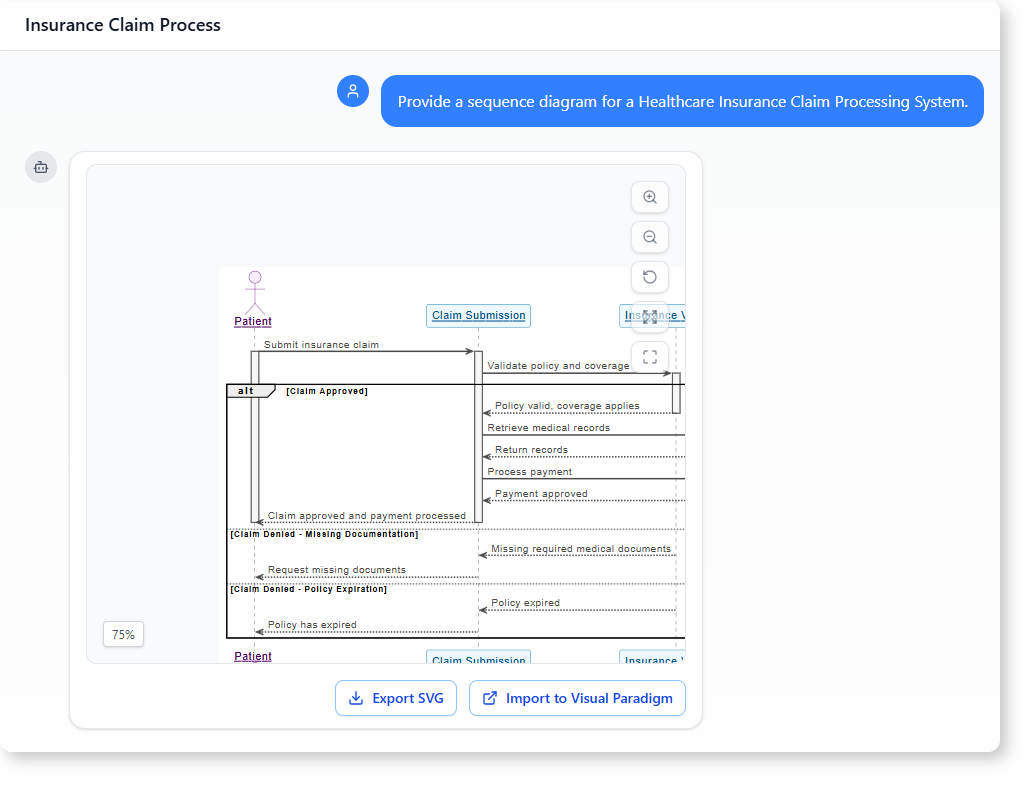Now Reading: How AI-Powered Modeling Software Builds a Healthcare Insurance Claim Process
-
01
How AI-Powered Modeling Software Builds a Healthcare Insurance Claim Process
How AI-Powered Modeling Software Builds a Healthcare Insurance Claim Process
How AI-Powered Modeling Software Builds a Healthcare Insurance Claim Process
Imagine you’re a healthcare operations manager trying to understand how a claim gets processed. You need to see exactly who handles what, when, and under what conditions. With traditional tools, mapping this out can take hours. But with AI-powered modeling software, the entire workflow becomes clear in minutes.
This isn’t just about drawing diagrams. It’s about understanding complex systems — like insurance claim processing — and seeing them unfold step by step.

A Real-World Use Case: Mapping Claim Processing
The user is a healthcare operations analyst working with a health insurance provider. Their team receives thousands of claims each month, and there’s no standard view of how each one moves through the system. They need to explain the process to stakeholders, identify delays, and ensure compliance.
Instead of manually drafting a sequence diagram or relying on outdated documentation, they turn to an AI-powered modeling tool. Their goal is simple: to visualize the entire claim processing journey — from submission to payment — and then generate a clear report on the start and end points of that journey.
Step-by-Step Journey with the AI-Powered Modeling Software
The user begins with a straightforward prompt:
‘Provide a sequence diagram for a Healthcare Insurance Claim Processing System.’
The AI interprets this request and builds a dynamic, interactive sequence diagram that maps every key interaction in the process — from patient submission to final payment or denial.
The diagram shows the flow of the claim through the system, including both approved and denied paths. It highlights key participants: the patient, the claim submission module, the insurance validator, medical records database, and the claims payment system.
Next, the user asks:
‘Write a report outlining the start and end points of the process shown in this sequence diagram.’
The AI doesn’t just repeat the steps. It synthesizes the information into a clear, structured report that identifies:
- The initial trigger: patient submits a claim
- The final outcomes: claim approved and payment processed, or denied due to missing documents or policy expiration
- The decision points that influence the process
- The system components involved at each stage
This isn’t just a diagram. It’s a narrative of how the system works — with clarity, context, and real-world relevance.
Why This Matters for Businesses Using AI Modeling Tools
Traditional modeling tools require users to define each element manually — participants, messages, lifelines — which can be time-consuming and error-prone. With AI-powered modeling software, the process becomes intuitive.
Users don’t need to know UML syntax or diagramming rules. They simply describe the system in natural language, and the tool handles the rest.
This approach is especially useful in industries like healthcare, where claim workflows are complex and often involve branching paths based on policy rules or document availability.
How AI Modeling Software Changes the Game
- It turns abstract workflows into visual, easy-to-understand sequences
- It captures both success and failure paths — including denials
- It supports clear documentation for audits, training, or stakeholder reviews
- It reduces the time needed to model complex systems from days to minutes
The result is not just a diagram, but a complete understanding of how the system operates.
What Users Get Back
With this AI-powered modeling software:
- A clear, professional sequence diagram showing all interactions
- A detailed report that explains where the process starts and ends
- A breakdown of conditional paths (e.g., claim approved vs. denied)
- A system that reflects real-world business logic — not just theory
This level of insight helps teams improve claim accuracy, reduce processing time, and communicate better with patients and internal departments.
Frequently Asked Questions
What types of systems can AI-powered modeling software handle?
This tool works well with any system involving step-by-step interactions between participants. Examples include insurance claims, order fulfillment, customer service workflows, and software integration paths.
Can it generate diagrams for healthcare insurance claim processing?
Yes. The AI can create a sequence diagram for a healthcare insurance claim processing system, showing how claims move from patient submission to final decision.
How does the AI ensure the diagram reflects real business rules?
The AI uses natural language understanding to interpret business scenarios. When a user describes a process, it maps the logic accurately — including conditional branches like missing documentation or policy expiration.
Is this tool suitable for non-technical teams?
Absolutely. The tool doesn’t require technical knowledge of UML or diagramming. Teams can describe a workflow in plain language, and the AI builds the visual and narrative components.
Ready to map out your system’s interactions? Give our AI-powered modeling software a try at Visual Paradigm’s AI Chatbot today!
